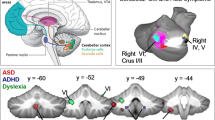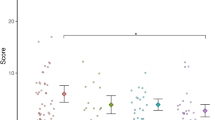Abstract
Structural changes of the cerebellum have been reported in attention-deficit/hyperactivity disorder (ADHD) in several studies. The cerebellum is a structure essential for motor coordination and motor learning. Beside behavioral deficits, children with ADHD often show slight motor abnormalities. In the present study, handwriting was examined in both children with ADHD and children with cerebellar lesions. By writing the same sentence several times, letter height increased in the ADHD and cerebellar groups but not in controls. Comparable disorders of handwriting in cerebellar and ADHD children support previous studies, which suggest a contribution of cerebellar dysfunction to motor abnormalities in ADHD. However, an involvement of non-cerebellar dysfunctions in ADHD cannot be excluded.


Similar content being viewed by others
References
Andreasen NC, Flashman L, Flaum M, Arndt S, Swayze 2nd V, O'Leary DS, et al. Regional brain abnormalities in schizophrenia measured with magnetic resonance imaging. J Am Med Assoc. 1994;272:1763–9.
Andreasen NC, O'Leary DS, Cizadlo T, Arndt S, Rezai K, Ponto LL, et al. Schizophrenia and cognitive dysmetria: a positron-emission tomography study of dysfunctional prefrontal-thalamic-cerebellar circuitry. Proc Natl Acad Sci USA. 1996;93:9985–90.
Palmen SJMC, van Engeland H, Hof PR, Schmitz C. Neuropathological findings in autism. Brain. 2004;127:2572–83.
Nicolson RI, Fawcett AJ, Dean P. Developmental dyslexia: the cerebellar deficit hypothesis. Trends Neurosci. 2001;24:508–11.
Castellanos FX, Lee PP, Sharp W, Jeffries NO, Greenstein DK, Clasen LS, et al. Developmental trajectories of brain volume abnormalities in children and adolescents with attention-deficit/hyperactivity disorder. JAMA. 2002;288:1740–8.
Berquin PC, Giedd JN, Jacobsen LK, Hamburger SD, Krain AL, Rapoport JL, et al. Cerebellum in attention-deficit hyperactivity disorder: a morphometric MRI study. Neurology. 1988;50:1087–93.
American Psychiatric Association. Diagnostic and statistical manual of mental disorders, text revision (DSM-IV-TR). 4th ed. Washington: American Psychiatric Press Inc; 2000.
Karatekin C, Markiewicz SW, Siegel MA. A preliminary study of motor problems in children with attention-deficit/hyperactivity disorder. Percept Mot Skills. 2003;97:1267–80.
Tervo RC, Azuma S, Fogas B, Fiechtner H. Children with ADHD and motor dysfunction compared with children with ADHD only. Dev Med Child Neurol. 2002;44:383–90.
Frings M, Gaertner K, Buderath P, Christiansen H, Schoch B, Gerwig M, et al. Timing of conditioned eyeblink responses is impaired in children with attention-deficit hyperactivity disorder (ADHD). Exp Brain Res. 2010;201:167–76.
Buderath P, Gaertner K, Frings M, Christiansen H, Schoch B, Konczak J, et al. Postural and gait performance in children with attention-deficit-hyperactivity-disorder. Gait Posture. 2009;29:249–54.
Bing R. Über einige bemerkenswerte Begleiterscheinungen der “extrapyramidalen Rigidität”(Akathisie-Mikrographie-Kinesia paradoxa). Schweiz Med Wsch. 1923;53:167–71.
Petitpierre M. Über den Antagonismus zwischen der “parkinsonistischen” Mikrographie und der cerebellaren Megalographie. Schweiz Arch Neurol Psychiatr. 1925;17:270–82.
Holmes G. The symptoms of acute cerebellar injuries due to gunshot injuries. Brain. 1917;40:461–535.
Thomas A. La fonction cérébelleuse. Paris: Doin et fils; 1911.
Racine MB, Majnemer A, Shevell M, Snider L. Handwriting performance in children with attention deficit hyperactivity disorder (ADHD). J Child Neurol. 2008;23:399–406.
Tucha O, Lange KW. Handwriting and attention in children and adults with attention deficit hyperactivity disorder. Mot Control. 2004;8:461–71.
Lange KW, Tucha L, Walitza S, Gerlach M, Linder M, Tucha O. Interaction of attention and graphomotor functions in children with attention deficit hyperactivity disorder. J Neural Transm Suppl. 2007;72:249–59.
Adi-Japha E, Landau YE, Frenkel L, Teicher M, Gross-Tsur V, Shalev RS. ADHD and dysgraphia: underlying mechanisms. Cortex. 2007;43:700–9.
Trouillas P, Takayanagi T, Hallett M, Currier RD, Subramony SH, Wessel K, et al. International cooperative rating scale for pharmacological assessment of the cerebellar syndrome. J Neurol Sci. 1997;145:205–11.
Conners CK. Conners' rating scales—revised CRS-R. North Tonawanda: MHS; 1997.
Phillips JG, Bradshaw JL, Chiu E, Bradshaw JA. Characteristics of handwriting of patients with Huntington's disease. Mov Disord. 1994;9:521–30.
Beversdorf DQ, Anderson JM, Manning SE, Anderson SL, Nordgren RE, Felopulos GJ, et al. Brief report: macrographia in high-functioning adults with autism spectrum disorder. J Autism Dev Disord. 2001;31:97–101.
Acknowledgements
The study was supported by an institutional research grant from the University of Duisburg-Essen (IFORES-program D/107-20180 and D/107-20170).
Conflicts of interest
The authors reported no potential conflicts of interest. The authors have no financial disclosures.
Author information
Authors and Affiliations
Corresponding author
Rights and permissions
About this article
Cite this article
Frings, M., Gaertner, K., Buderath, P. et al. Megalographia in Children with Cerebellar Lesions and in Children with Attention-Deficit/Hyperactivity Disorder. Cerebellum 9, 429–432 (2010). https://doi.org/10.1007/s12311-010-0180-y
Published:
Issue Date:
DOI: https://doi.org/10.1007/s12311-010-0180-y




